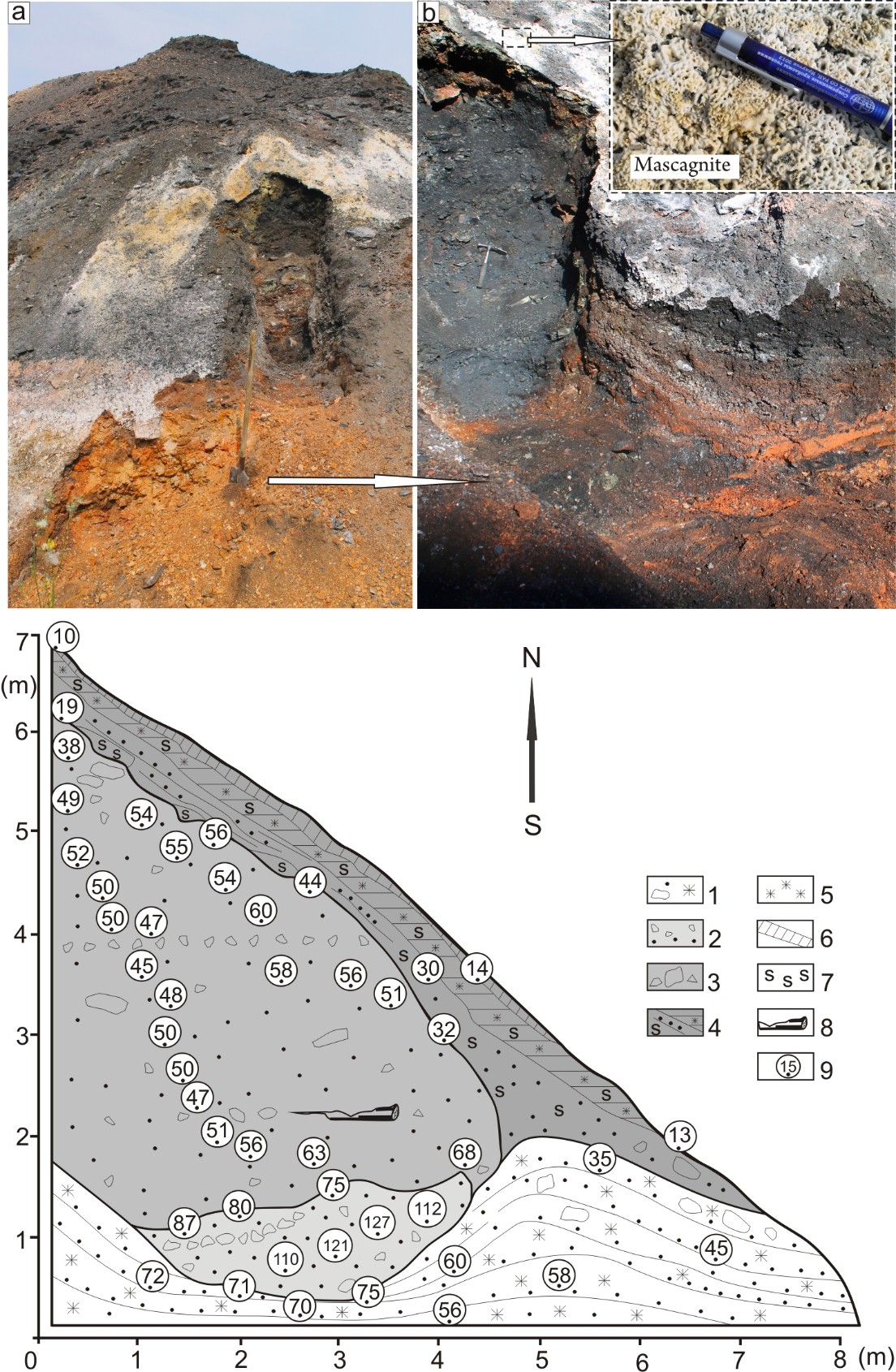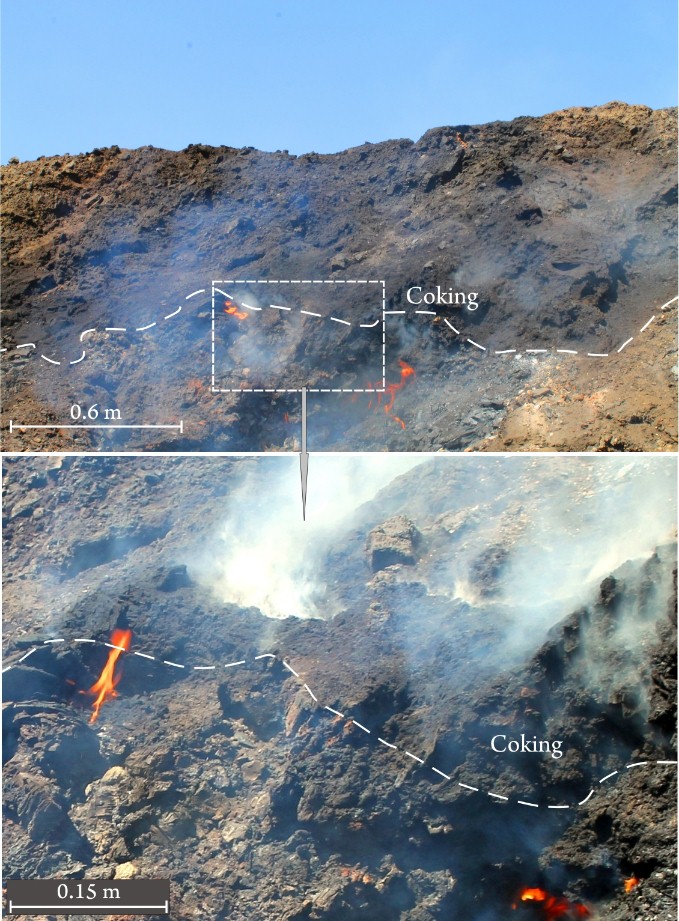
| Version | Summary | Created by | Modification | Content Size | Created at | Operation |
|---|---|---|---|---|---|---|
| 1 | Nikolay Ivanovich Akulov | + 2339 word(s) | 2339 | 2020-04-23 13:09:24 | | | |
| 2 | Nora Tang | -58 word(s) | 2281 | 2020-10-29 07:15:15 | | |
Video Upload Options
Hydrocarbon products formed under high-temperature and low-temperature pyrolysis of coal-bearing rocks were studied by using a chromatography-mass spectrometer GCMS-QP2010NC Plus (made by Shimadzu Company). The average temperature of low-temperature natural pyrolysis does not exceed 120°C, and its average speed is approximately 2 m/year. In this case, three pyrolysis zones gradually built metamorphic rock mass (from bottom to top) are clearly established: heating (focal) activated and enriched. The average temperature of high-temperature pyrolysis reaches 850°C, and its average speed is approximately 20 m/year. Unlike low-temperature pyrolysis, high-temperature pyrolysis is accompanied by the presence of two major zones (from bottom to top): pyrogenic (focal) and enriched (coke). The chemical composition of the enriched pyrolysis zone was studied in detail. It has been established that hydrocarbon compounds in samples of the pyrolysis zone are presented by six classes: asphaltic-resinous substances; polycyclic aromatic hydrocarbons, heterocyclic compounds, organic sulphur compounds; pyrolytic hydrocarbon and heavy hydrocarbon residue. Quantitative content of hydrocarbon compounds in the analyzed samples varies from 0.35% to 41.88%.
Based on the materials of fieldwork, we created a video film that can be seen on the website https://youtu.be/Tqs6YiKfDdE
Research Results
In the course of long-standing research of pyrolysis products of technogenic-redeposited coal-bearing series in mine opening of spoil heaps, three successively upward pyrolysis zones were found: the heat zone, activated zone and enriched zone (Figure 1). These conventionally marked zones in the form of halos outline a thermally modified red-colored metamorphic rock mass. Metamorphic mass (MM) is represented by the red-colored clastic mass of thermally altered rocks. Due to the high porosity (about 30%) of the technogenic-redeposited rock mass and the prolonged thermal effect, the fragments of this zone of the terricone are gradually oxidized and turn into a red-colored massif. The average temperature of the metamorphic mass adjoined to the rocks that are under the pyrolysis influence is around 50°C, although in the areas of contact with the heat zone it reaches 75°С (Figure 2).
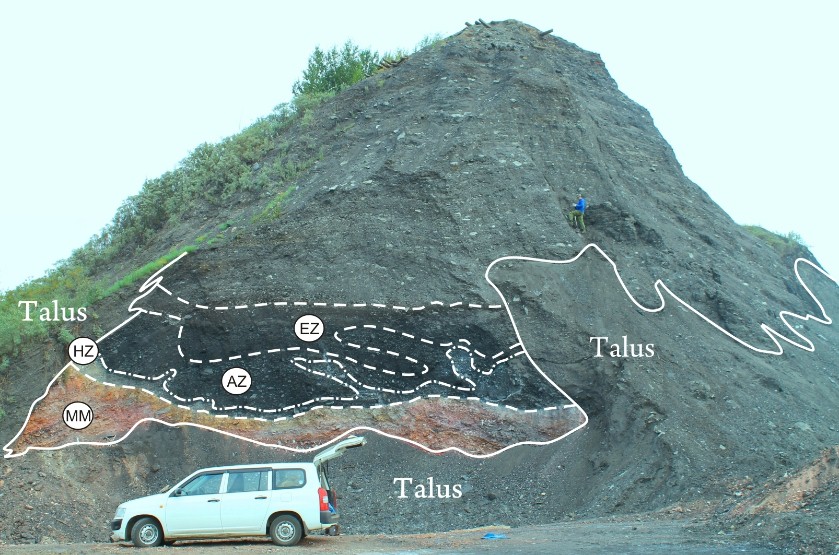
Figure 1. Type section of quiet spoil heap Ch-09 in Cheremhovo. The red rocks of metamorphic massif (MM) are deposited in the basement. On the metamorphic massif, the "Black block" of pyrolysis rocks is superposed, within which the following zoning is delineated: EZ- enriched zone; AZ- activated zone; HZ- heat zone. The "Black block" is overlapped by sandy and clay deposits with debris of fine and medium sandstones.
Heat Zone
The heat zone (HZ) is composed of gray sand and slag remaining products, formed by pyrolysis of coal-bearing deposits in alkali reductive conditions. Its thickness is inconstant and ranges from 0.03 to 0.6 m. An average temperature of rocks in a similar area of the pyrolysis process is about 115°С, while it was found out that its maximum reaches 127°С (Figure 2).
Figure 2. Sketch sectional drawing of active low- temperature pyrolysis chamber, which shows the pyrolysis zoning and temperature distribution of epigenetically changed coal-bearing rocks (spoil heap Ch-05, the southern hillside). 1— metamorphic zone; 2— heat (focal) zone; 3— activated zone; 4— enriched zone; 5— areas impregnated with light brown ferrum hydroxides; 6—areas of concentration of white mascagnite – (NH4)2SO4; 7—areas of crystallized sulphur clusters, 8—the location of activated wood, 9— rock temperature measured with pyrometer, the point in the circle indicates the measurement location.
Activated Zone
The activated zone (AZ) is black and consists of solid activated hydrocarbon products of pyrolysis, including fragments of wood modified into charcoal. Most parts of this zone are represented by fragments of coal caked in the form of coal-bearing semi-coke or transformed into heavy fractured coal with bright anthracite lustre (Figure 3). Pyrolysis gases, passing through this zone, colour all the debris of rocks in black. The thickness of the AZ changes over the range of 1.4–2.8 m. The average temperature of rocks is approximately 50°С, and its fixed maximum does not exceed 63°С.
It is important to note that the metamorphic zone consists of weakly cemented iron hydroxides of gravelly-sandy-clayey yellowish-brown deposits, with an average temperature of about 50°C; the heat (focal) zone is represented by grey-colored dry loose rubble-sandy intensively modified coal-bearing mass with an average temperature of about 115°C; the activated zone is composed of grey-colored dry loose rubble-sandy coal-bearing material with sticks of activated wood (an average temperature is about 50°C); the enriched zone is represented by dark grey wet and porous pyrolysis products, commonly impregnated with sulphur, and occasionally – with ferrum hydroxides and ammonium sulphate (average temperature is about 30°C).
Enriched Zone
The enriched zone (EZ) differs enormously from the above-described zones by the presence of variegated solid wet highly-porous as well as uliginous oily pyrolysis products. Their variegation is caused by the presence of floury white sulfates (mascagnite and tschermigite), as well as the concentration of greenish-yellow sulphur, black asphaltenes and numerous hydrocarbon compounds, painted in various shades of brown. The unique feature of this zone is the presence of native sulphur, deposited as a well-crystallized near surface feature in the form of nests, the sizes of which reach 0.6 × 0.3 m. The largest (up to 7 mm) sulphur crystals are found nearby the middle part of the EZ. They are always coincided with large (more than 0.25 m) intensively modified sandstone debris and are arranged in the form of nests in their footprints. It is significant that fine-crystalline (up to 3 mm) sulphur in the form of long acerate crystals penetrates all tender ground mass of pyrolysis products (Fig. 3). Terricolytes are very tough metamorphically modified dark gray rocks. According to our RFA data, they have the following composition (%): SiO2 (51.87-71.29); С (20.66-27.87); Al2O3 (0.20-17.15); S(total) (0.41-3.51); Fe2O3 (0.07-1.86); MgO (0.02-1.05); K2O (0.01- 0.63); CaO (0.02-0.68); TiO2 (0.02-0.39); Na2O (0.01-0.03); P2O5 (0.03-0.04); F (0.31-0.50). Their inorganic mass is often represented by pure α-quartz with a dash of native sulphur, as well as hematite, smectite, gypsum and anhydrite.
The thickness of the EZ does not exceed more than 5.5 m. The average temperature in a similar area of low-temperature pyrolysis is 30°С, and the maximum temperature near to the AZ reaches 40 °С.
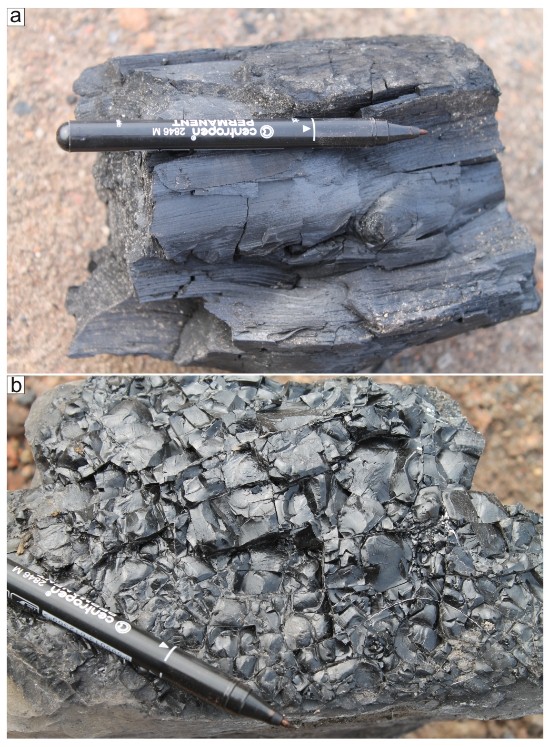
Figure 3. Products from pyrolysis activated zone: a-activated charcoal; b-heavy fractured coal with bright anthracite luster.
Fumarole Channels
The point to be emphasized is that a large part of gasified organic and inorganic compounds in conjunction with pyrolysis water vapor penetrated through a porous structure of pyrolysis products of this zone, escapes into the atmosphere. In the event that EZ is superposed by a significant mass of rocks, gassed pyrolysis products penetrate them through numerous fumaroles, and then escape into the atmosphere. Concentration of fumaroles on the surface of spoil heaps is easily found by vapor jets coming from them, oily resinous pyrolysis aureole spread around them and specific smudge of pyrolysis gases. A lot of pyrolysis products gather around the fumaroles that conduce pyrolysis hills building, the accumulation of which often forms range of pyrolysis spoil heaps (Figure 4). The surface of such ranges is covered with black highly porous and poorly cemented asphaltenes, containing numerous sulphur crystals. Fumaroles temperature measurements showed that pyrolysis products temperature in their "craters" is 62°С, and it reaches 85°С in their "necks" at a depth of one meter from the surface.
Figure 4. The main products of active fumaroles of spoil heap Ch-02: a— a general view of the pyrolysis products and conical structures of active fumaroles; b— a "crateral" part of fumaroles contoured by greenish-yellow authigenic sulphur; c— oily resinous pyrolysis products; d— a section of active pyrolysis fumarole, consisting of sulphur and hydrocarbon compounds, with an indication of sampling locations.
According to the data obtained as a result of mass spectrometry analysis, samples Ch-02/1 and Ch-02/2, selected nearby and on the surface of the enriched zone (Figure 4d), contain asphaltic-resinous substances with relative intensities of peaks: for 57 from 81% to 100%, for 155 at–3%. Polycyclic aromatic compounds included in their composition are presented by phenanthrene, anthracene, acenaphthene, pyrene, fluoranthene, chrysene, benzaanthracene and naphthalene. Where mass content of phenanthrene is twice as much as mass contents of other, polycyclic aromatic compounds. The total pyrolysis products content reaches 220.000 mg/kg.
Figure 5. Section of pyrogenesis mass of coal-bearing deposits on the eastern hillside of spoil heap Ch-05. The bottom fragment shows the area of high- temperature pyrolysis, occurring under pyrogenesis that promotes coking, and then high- temperature burning of rock fragments and their subsequent caking.
Light-brown oily pyrolysis units of the enriched zone are coincided with the fumaroles, where they cover the surface of spoil heaps in the form of small spots with a thin (1.5 cm) crust. They are presented by the congeries of encrustations of various sizes and forms (Fig. 4b). The sample Ch-02/5 has a high content of the pyrolysis hydrocarbon compounds that reaches 328.125 mg/kg. The group composition of polycyclic hydrocarbons is similar to the sample Ch-02/2, selected nearby the surface of the enriched zone, except for benzo (a) pyrene. It is worth noting that these light-brown oily pyrolysis units have the highest content of phenanthrene—1074 mg/kg— and anthracene—109.7 mg/kg.
Unconsolidated light gray hot (up to 83°С) and wet authigenic minerals with numerous crystals and hollow druses of sulphur are revealed in relatively deep parts of the enriched zone (0.25 m—Ch-02/3 and 0.5 m—Ch-02/4). Group composition of polycyclic aromatic compounds is similar to samples collected nearby and on the surface of the enriched zone, but their contents are one order less. Furthermore, in these samples, negligible contents of benzo (b) fluoran, benzo (k) fluoran, benzo (a) fluoran are revealed, but naphthalene is missing. The total pyrolysis products content decreases to 27.375 mg/kg.
High-Temperature Pyrolysis
We managed to make a clearing of the current fire source in the zone of high- temperature pyrolysis and identify the pyrolysis zonal sequence in its section (Figures 5 and 6). It has been established that its heating (focal) area is much larger than the same zones under low- temperature pyrolysis, and reaches more than 3.5 m. Statistical analysis of temperature measurement results in this zone showed that its average value is 790°С, and recorded maximum temperature reaches 854°С. The size of the activated zone is substantially reduced, moreover in some places this zone is missing, and there is a slow high- temperature combustion of the rock mass at the contact with the pyrolysis products of enriched zone. In the places of oxygen access, pyrolysis products inflammation and open combustion of rocks are observed. The average temperature of the rocks in the activated zone is 230°С, and its fixed maximum temperature is 264°С. Under natural high-temperature pyrolysis, the basement of the enriched zone is extremely wavy, and the thickness of the zone reaches four meters. The average temperature of hydrocarbon products in this zone is 60°С, and near to the basement its maximum value reaches 177 °С. It is observed that the closer to the surface of the enriched zone, the lower temperature of the rock is. Every ten centimeters, the temperature drops by12 °С sharply, and the average temperature of the ground surface is 20 °С
In conclusion, it is worth emphasizing that conducted the numerous conducted chemical analyses of metamorphically modified rocks under pyrolysis showed that the metamorphic rocks are close to unaltered protolith sandstones and protolith coals are similar to the rocks of the pyrolysis enriched zone in their compositions. In the performance of the silicate analysis, the entire mass of organic pyrolysis products burnt down, changing over to loss on ignition. Therefore, it was found that under natural pyrolysis, the distribution of the silica in different rocks of pyrolysis zones is inversely proportional to the amount of the pyrolysis products that is clearly confirmed by their polynominal curves.
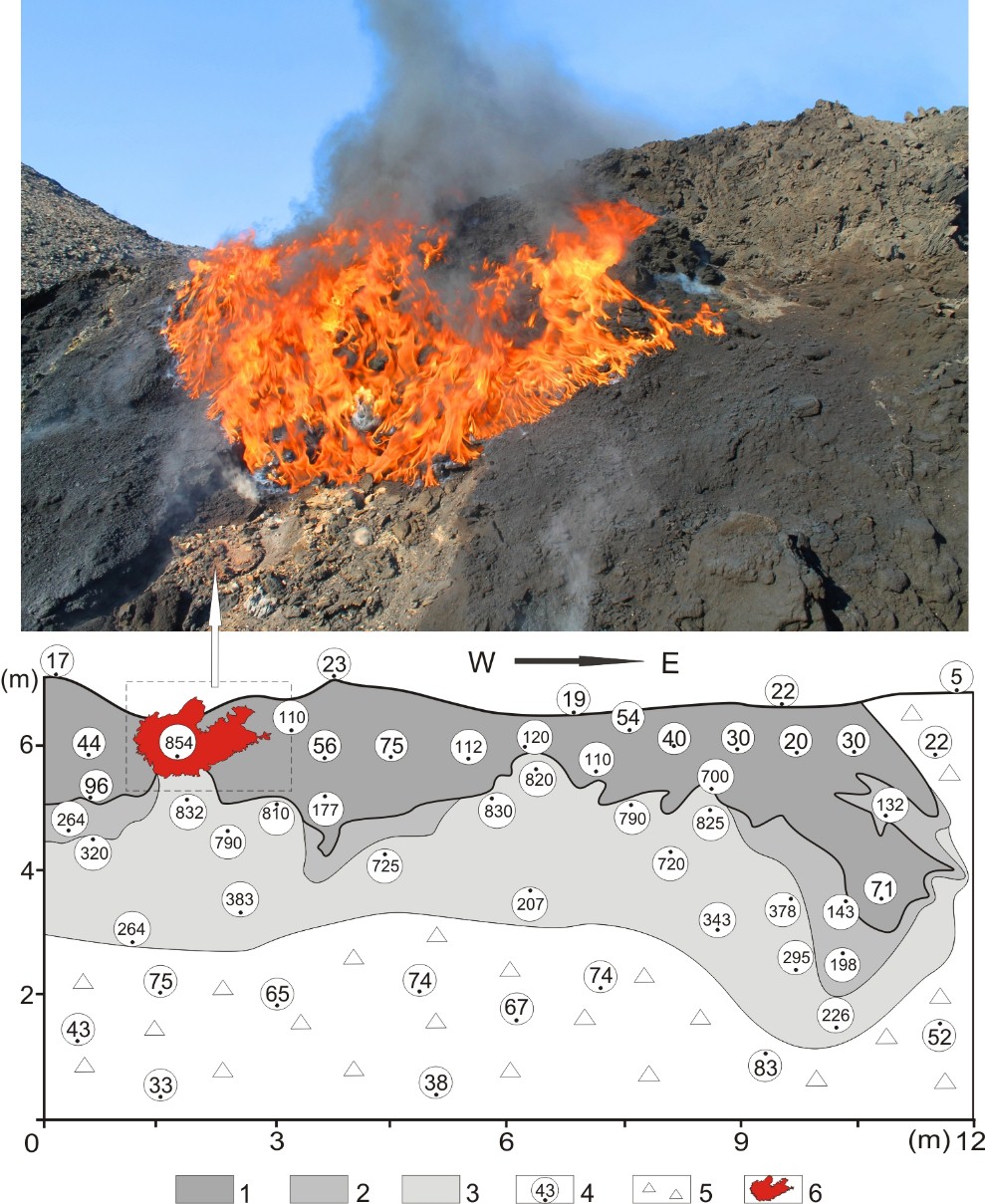
Figure 6. Sketch sectional drawing of active high- temperature pyrolysis focus, in the western part of which pyrogenesis of hard pyrolysis products of coal-bearing rocks (spoil heap Ch-05, the western hillside) occurs: 1—hydrocarbon products of enriched pyrolysis zone (average temperature is about 60°C), 2— activated zone (average temperature is about 230°C), 3— heat zone (average temperature is about 790°C); 4— temperature measured with pyrometer in the point indicated in the circle; 5— talus; 6— pyrogenesis of rocks in the zone enriched by hydrocarbon compounds.
To summarize, it should be emphasized that the study of pyrolysis of coal-bearing deposits of spoil heaps represents one of the most interesting and important multidisciplinary problems. A large number of hydrocarbon compounds and native sulphur generated during long-term low- temperature pyrolysis of technogenic-redeposited coal-bearing mass contributes to the spontaneous combustion of sulphur pyrolysis products and the beginning of the pyrogenic process. Hydrocarbon compounds combustion is accompanied by high-temperature transformations, sometimes liquefaction of sedimentary rock debris with the formation of paralava and high-temperature flash pyrolysis of superincumbent coal-bearing deposits with the formation of semi-coke and coke.
Importantly, due to relatively rapid combustion in the process of pyrogenesis, in the enriched pyrolysis zone, the formation of such a large number of hydrocarbon products as under low- temperature pyrolysis goes behind. The above process of epigenetic changes of technogenic-redeposited coal-bearing deposits of spoil heaps allowed the following chain of sequential irreversible transformation to be established:
The study of spontaneous pyrolysis of coal-bearing rocks of different spoil heaps allowed the following regularities to be identified.
- The average temperature of low- temperature natural pyrolysis does not exceed 120 °С, and an average speed of its course is about 2 m/year. Furthermore, the presence of three pyrolysis zones which build metamorphic rock mass (from bottom to top) gradually is clearly established: heating (focal), activated and enriched.
- In the products of low-temperature pyrolysis, natural sulphur and asphaltic-resinous substances dominate. The polycyclic hydrocarbons class is represented by 13 types of hydrocarbons compounds. Pyrolytic carbon and heterocyclic compounds are important products for natural low- temperature pyrolysis.
- High-temperature pyrolysis temperature reaches 854 °С, and an average speed of its course is about 20 m/year. High-temperature pyrolysis is accompanied by the presence of two major zones (from bottom to top): pyrogenic (focal) and enriched (coke).
- The distribution of silica content in the rocks of various pyrolysis zones is inversely proportional to the number of pyrolysis products.


